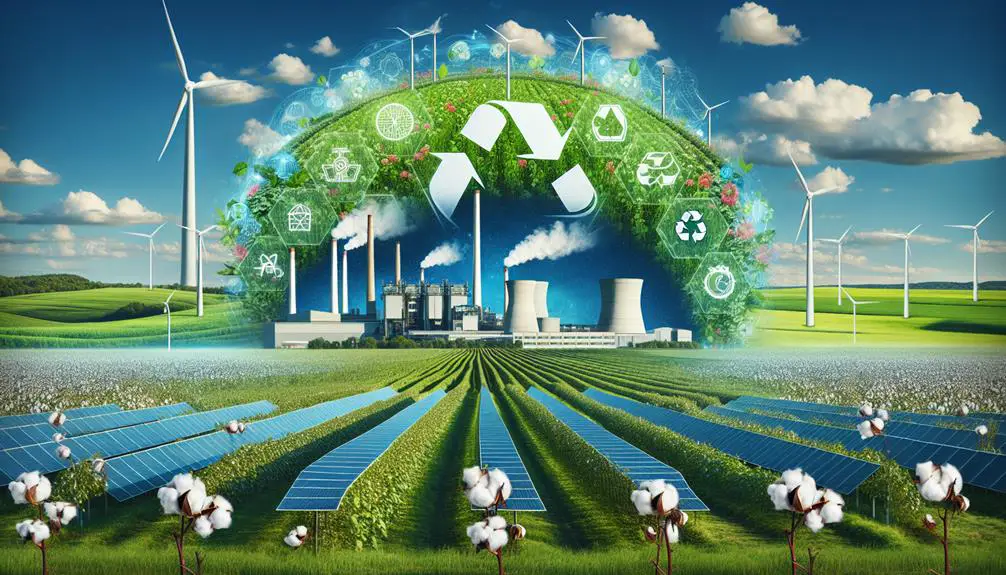You might think sustainable textiles are merely a trend, but their economic implications run deep. Producing eco-friendly materials like organic cotton and recycled polyester isn't just about higher farming standards; it also means greater costs for manufacturers who must adapt machinery and navigate new supply chains. Yet, there's a silver lining for retailers—embracing sustainability could boost your competitive edge as consumer demand for ethical fashion rises. How do these dynamics play out in the market, and what long-term financial benefits might you expect? Let's explore the intricate balance between cost and opportunity in sustainable textiles.
Table of Contents
Key Takeaways
- Sustainable textiles involve higher production costs due to specific farming practices, certifications, and ethical sourcing.
- Manufacturers face increased costs from adapting machinery, new technology, and longer lead times with global suppliers.
- Retailers can gain a competitive edge and build customer loyalty by integrating and marketing sustainable textile practices.
- Eco-conscious consumers drive demand for products made from organic, recycled, or upcycled materials, emphasizing quality and ethical production.
- Sustainable textiles offer long-term financial benefits through decreased waste, reduced energy consumption, and potential regulatory incentives.
The Cost of Sustainable Materials
When you're considering sustainable textiles, the cost of materials often becomes a significant factor. The journey from raw material to finished product involves a complex supply chain, and each step can influence the final price. Understanding these dynamics is essential for making informed decisions.
First, let's talk about production costs. Sustainable materials like organic cotton, bamboo, and recycled polyester typically come with higher price tags. These materials require specific farming practices, advanced technology, and rigorous certifications, all contributing to increased costs. For example, organic cotton avoids synthetic pesticides and fertilizers, which means more labor and lower yields, driving up production costs.
Next, the supply chain itself plays a pivotal role. Sourcing eco-friendly materials often means dealing with smaller suppliers who mightn't benefit from economies of scale. Transporting these materials in an environmentally friendly way, such as using lower-emission shipping methods, also adds to the expenses. Additionally, ensuring fair wages and ethical working conditions at every stage of the supply chain further elevates costs.
Economic Impact on Manufacturers
Manufacturers face significant economic challenges as they navigate the higher costs associated with sustainable textiles. You're dealing with heightened prices for eco-friendly raw materials, which can strain your budget. These materials often come with a premium due to their ethical sourcing and limited availability. As you shift to sustainable practices, you'll encounter manufacturing challenges like adapting existing machinery or investing in new technology. This change isn't just a financial burden; it requires time and expertise to ensure smooth integration.
Moreover, supply chain implications add another layer of complexity. Sourcing sustainable materials often involves working with new suppliers who may be located in different parts of the world. This can lead to increased lead times and logistical hurdles. You need to establish strong relationships with these suppliers to guarantee a consistent and reliable flow of materials. Additionally, transparency in your supply chain is vital but difficult to achieve, as it requires rigorous tracking and reporting.
Despite these challenges, embracing sustainable textiles can position you as a leader in an increasingly eco-conscious market. By overcoming these obstacles, you not only contribute to environmental preservation but also potentially open up new business opportunities and foster consumer loyalty.
Retailers and Market Dynamics
As a retailer, embracing sustainable textiles could reshape your market dynamics and give you a competitive edge in an eco-conscious consumer landscape. By integrating sustainable practices into your supply chain, you can enhance transparency and build trust with your customers. A robust, transparent supply chain not only guarantees the authenticity of your sustainable claims but also minimizes disruptions and improves efficiency.
When it comes to pricing strategies, adopting sustainable textiles might initially seem costlier. However, consider the long-term benefits: reduced waste, improved resource efficiency, and increased customer loyalty. These factors can offset higher upfront costs and even lead to greater profitability. Implement dynamic pricing strategies that reflect the value of sustainability, emphasizing the quality and ethical aspects of your products.
Moreover, staying ahead in the market means continually adapting and innovating. By offering sustainable textiles, you position yourself as a leader in a growing niche. This proactive approach can attract a dedicated customer base willing to pay a premium for products that align with their values.
Embrace marketing campaigns that highlight your commitment to sustainability and educate consumers about the advantages of your eco-friendly textiles. This strategy not only drives sales but also fortifies brand loyalty.
Consumer Spending Trends
Eco-conscious consumers are increasingly prioritizing sustainable textiles in their spending habits. You'll notice a significant shift, especially among millennials, who are at the forefront of this change. Their preferences are driven by deep environmental concerns and a commitment to ethical fashion. They're not just buying clothes; they're making statements about their values.
Conscious consumption is reshaping the textile market. You're likely seeing a growing demand for products made from organic, recycled, or upcycled materials. This trend isn't just a fad; it reflects a broader awareness of the impact of fast fashion on our planet. Millennials, in particular, are scrutinizing brands more than ever before, rewarding those that practice transparency and sustainability.
By choosing sustainable textiles, you're supporting a movement that values quality over quantity. Ethical fashion isn't just about the materials used; it's also about fair labor practices and reducing waste. When you invest in these products, you're contributing to a more sustainable future.
Your spending power can drive change. By embracing these trends, you're not only making a stylish choice but also a responsible one. Sustainability is more than a buzzword; it's a commitment to a better world.
Long-Term Financial Benefits
To summarize, investing in sustainable textiles can result in substantial long-term financial savings. When opting for sustainable practices, you're not only contributing to environmental conservation but also laying the groundwork for remarkable investment returns. Sustainable textiles may require higher initial investments, but these costs are swiftly balanced out by the enduring advantages.
Decreased waste and reduced energy consumption directly lead to financial gains, which enhance your profitability. By concentrating on resource efficiency, your company can cut down on expenses associated with water and energy usage. Effective resource management leads to less wastage of raw materials and lower utility costs, streamlining your operations and making them more economical. These financial savings accrue gradually, making a significant positive impact on your financial performance.
Furthermore, sustainable practices can appeal to environmentally conscious consumers who are willing to pay extra for ethically manufactured products. This strengthens your position in the market and drives up sales, ultimately increasing your profitability. Moreover, regulatory incentives and tax benefits for sustainable practices can improve your overall investment returns.
Ultimately, the lasting financial advantages of sustainable textiles go well beyond mere cost reductions. They position your business for enduring growth, enhanced profitability, and a solid return on investment, all while making a positive contribution to the environment.
Frequently Asked Questions
How Do Sustainable Textiles Affect Employment in the Textile Industry?
You'll find that sustainable textiles can greatly impact the labor market in the textile industry. They often lead to job growth due to increased demand for eco-friendly processes, positively affecting the labor impact overall.
What Are the Primary Challenges in Sourcing Sustainable Materials?
You face primary challenges in sourcing sustainable materials due to a fragmented supply chain and significant cost implications. Maneuvering these complexities requires a deep understanding of logistics and financial strategies to achieve sustainability goals effectively.
How Do Government Policies Influence the Sustainable Textile Market?
Oh, isn't it delightful when government regulations make life harder? Yet, with market incentives, you'll find the sustainable textile market thriving. Policies can turn your eco-friendly dreams into reality or make them just dreams.
Are There Significant Technological Advancements Driving the Sustainable Textile Industry?
Yes, you're seeing significant technological advancements in the sustainable textile industry. Innovative techniques and eco-friendly practices are transforming production processes, boosting efficiency, and reducing environmental impact, positioning you for mastery in this evolving field.
How Do Sustainability Certifications Impact Consumer Trust in Textile Products?
You might think certifications are just marketing strategies, but they greatly boost consumer trust. Ethical sourcing reassures buyers, curbing greenwashing trends and positively influencing consumer behavior, leading to smarter, more sustainable purchasing decisions.
- How Does Ring Spun Cotton Affect Garment Fit and Shape Retention? - August 13, 2024
- What Are the Challenges in Producing Ring Spun Cotton? - August 13, 2024
- Is Ring Spun Cotton Suitable for Plus-Size Clothing? - August 13, 2024






